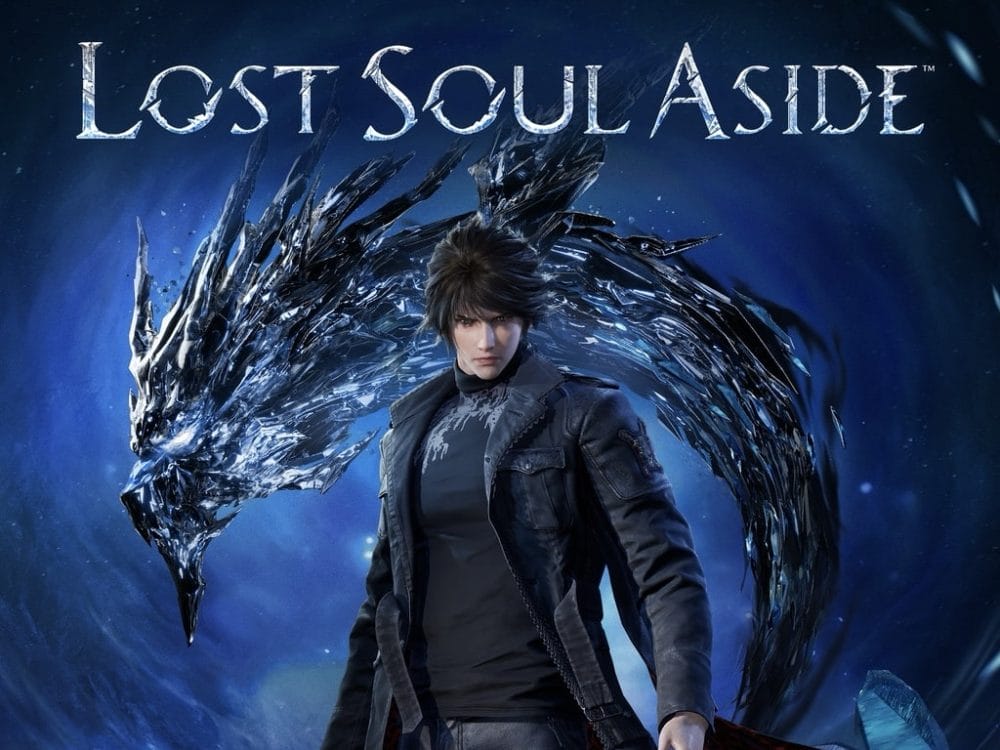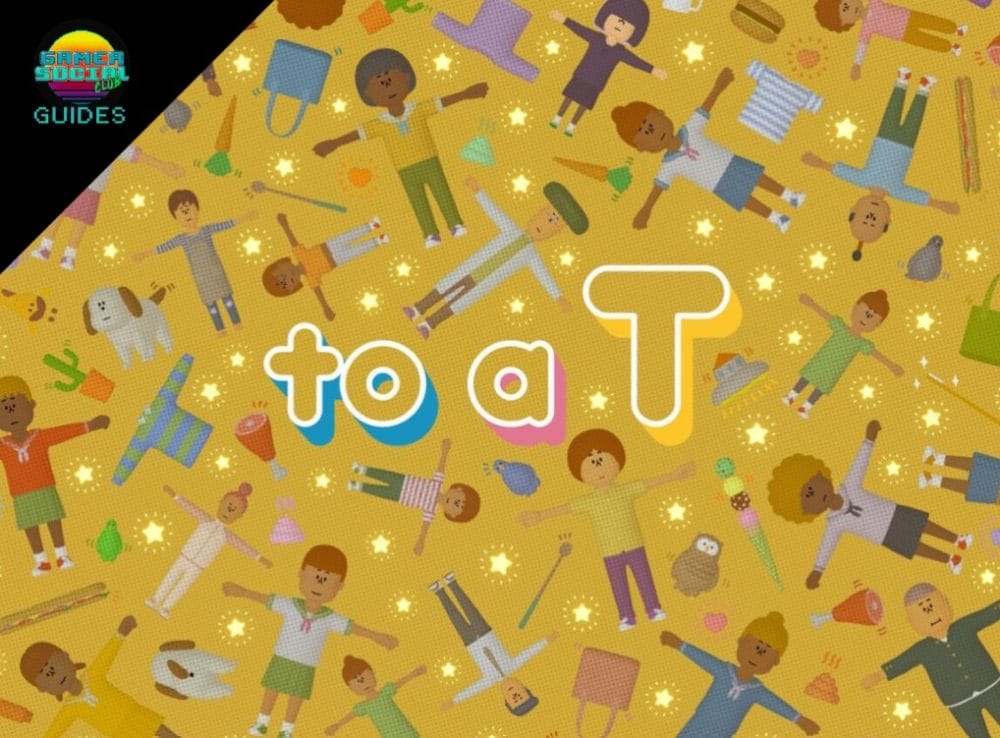After a decade-long hiatus, Dragon Age: The Veilguard marks a triumphant return to Thedas. BioWare has successfully breathed new life into the series, staying true to its roots while delivering a fitting conclusion to the story that began with Origins 15 years ago.
Fast forward 10 years, after countless rumors and a protracted development cycle, Dragon Age: The Veilguard has finally arrived in full. For this review, I dedicated over 100 hours to the game. I completed every available side quest, experienced a romance, and achieved what is considered “the best” ending. My journey was as a female Rook, a member of the Antivan Crows, and I romanced Lucanis. On Xbox, I earned 100% of the achievements.
Character Customization
Any great RPG begins with character customization, and BioWare truly delivers on this front. The game offers a robust customization system that lets you tailor your experience to your liking. You can select your character’s lineage-Elf, Qunari, Human, or Dwarf-and define their identity by choosing their gender and pronouns. If you’ve played the Veilguard already and loved the character you created, you’ll be pleased to know you can import that same character into a new game.
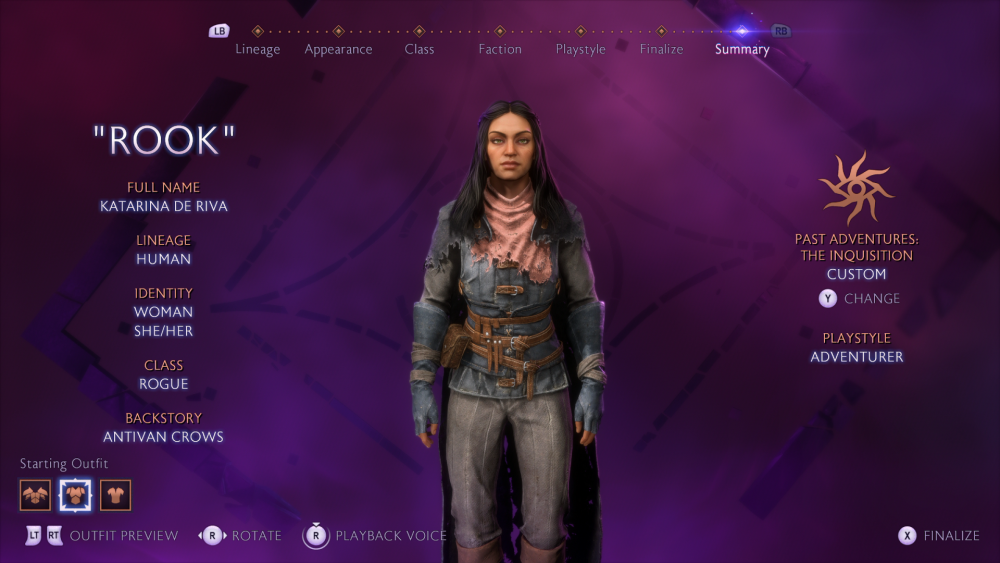
The character customization system covers all the standard categories: Head, Body, Eyes and Eyebrows, Nose, Mouth, Ears, Hair, Makeup, Tattoos, Scars, and Paint. One standout feature is the inclusion of different lighting setups, allowing you to preview your character in various environments. This is a great addition, especially for players who, like me, spent hours crafting their character in Inquisition only to have them look completely different in the first cutscene.
One area where BioWare has traditionally struggled is with hairstyle variety, however the Veilguard finally delivers. For the first time, I no longer feel compelled to default to a short haircut for my female character due to limited options. The variety is excellent, catering to a range of preferences, and the “hair physics” are nothing short of spectacular.
While this might not be a game-changer for everyone, I was genuinely impressed. Hair, especially longer styles, moves naturally during cutscenes, with strands shifting independently in a way that feels completely realistic. I literally could not stop looking at the hair … it was that good.
Classes and Factions
There are three standard character classes to choose from: Rogue, Warrior, and Mage. Each class can synergize well with companion classes, offering strategic flexibility. I played as a Rogue and often teamed up with another Rogue in my party. I encountered no issues with balance or effectiveness.
The game also introduces a wide range of starting factions to choose from. This is the most diverse selection in a Dragon Age game to date. Options include the Grey Wardens, Veil Jumpers, Shadow Dragons, Lords of Fortune, The Mourn Watch, and Antivan Crows. While factions don’t significantly alter the main story, they add flavor by providing unique dialogue options, relationships with certain NPCs, and game-specific perks. For example, selecting the Grey Wardens increases damage against darkspawn. Your faction also determines your character’s surname, which isn’t changeable, and provides a unique backstory for your character, referenced throughout the game.
Difficulty Settings and Playstyles
You can tailor your playstyle by selecting a difficulty level ranging from Storyteller (the easiest, focusing on narrative) to Nightmare (a true test of your skills). However, Nightmare is a one-time choice-once selected, you can’t change it without starting a new playthrough. Other difficulties allow for adjustments mid-game, which I appreciated. On Storyteller mode you can even turn on Prevent Death in the Gameplay menu. If combat felt too easy, I could increase the challenge until I found the perfect balance. Complaints about the combat being too easy seem unfounded, as the game gives you full control over difficulty.
Missable Inquisitor Customization
One drawback I discovered was the easily missable option to customize your Inquisitor from Dragon Age: Inquisition. This option appears on the “Finalize” screen, where you also select your character’s first name and voice (European or American). If you skip this step, the default Inquisitor is a Female Elf Lavellan who romanced Solas and vowed to pursue him after the Trespasser DLC. While I enjoyed this narrative for my first playthrough, it was disappointing to realize too late that I couldn’t bring back my own custom Inquisitor. Many players, myself included, felt this feature should have had its own dedicated screen, ensuring it wasn’t overlooked. At least now I have something to look forward to in a future playthrough.
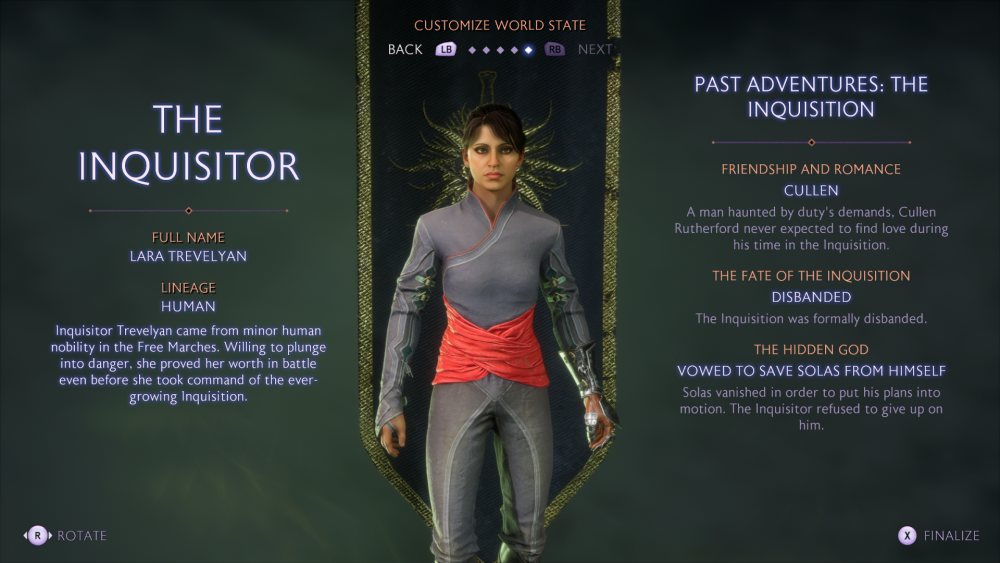
Previous Game Decisions
There has been significant criticism of Dragon Age: The Veilguard regarding the limited impact of decisions carried over from previous Dragon Age games. In Veilguard, players can customize their Inquisitor and make three key choices from Inquisition. More specifically the choices carry over from the Trespasser DLC: Who did you romance?, What was the fate of the Inquisition?, and Did you vow to stop Solas or redeem him?
While some fans feel these limited choices fail to reflect the complexity of their past decisions, I sympathize with BioWare’s approach. Maintaining the permutations of player choices across four games is an astronomical challenge. Do we truly need to revisit characters like the Warden, who hasn’t been a central figure since Origins? Personally, while I’ve enjoyed cameos like Alistair in past installments, it’s never been a dealbreaker for me. Each new Dragon Age game has been about creating a fresh character and embarking on a brand-new adventure, and that core experience remains intact.
Would I have loved to see more cameos or callbacks to previous characters? Of course. Did the absence of these elements diminish my enjoyment of the game? Not at all. That said, Veilguard does include a few cameos, and I was super happy when familiar faces appeared. These moments brought a smile to my face, even if they were few and far between.
Story
The story in Dragon Age: The Veilguard is really a love letter to the series, drawing on the very best BioWare has offered over the years. It’s a continuation of the series for fans who’ve been there since the beginning but also manages to create a soft reboot for new players who want to jump into the experience.
While the story can be considered somewhat linear, completionists will easily spend 80-100+ hours to experience everything the game has to offer. The game picks up eight years after the events of the Trespasser DLC in Dragon Age: Inquisition. You play as Rook, recruited by Varric Tethras to hunt down Solas and thwart his plan tear down the Veil.

Doom and Gloom
The game kicks off in the city of Minrathous, with an initial goal of finding Neve Gallus and disrupting Solas’s ritual. Things obviously go wrong and two elven gods, Elgar’nan and Ghilan’nain, are unleashed from their prisons unto the world. The opening of the game is intense and it drew me in right away. With the gods on the loose it’s Rook’s job to put together a team and bring factions together to take them on before Thedas is destroyed. It’s very reminiscent of Mass Effect 2 and the suicide mission.

This time around, we finally get to explore the Northern parts of Thedas. Your adventures will include the Crossroads, Tevinter, the Anderfels, Nevarra, Antiva, and Rivain. Each area is tied to a faction, and completing quests there raises your relevant faction reputation as well as the approval rating for your companion from that area.
While the Veilguard is a long game, I didn’t find it to suffer from bloat. All side quests pertain to strengthening your bonds with the factions or helping your companions solve personal struggles to prepare them for the battles ahead.
Levels and Exploration
Level design is nothing short of spectacular. This world offers AMAZING scenery and the games photo mode should be used liberally. Any worries about this game being “too bright and colorful” should be laid to rest. The game is dark where it needs to be dark and there is plenty of darkness to be had. The Qunari Antaam are on a rampage, Venatori blood mages run amok, the Blight continues to spread, and, of course, where there’s Blight, there are darkspawn.
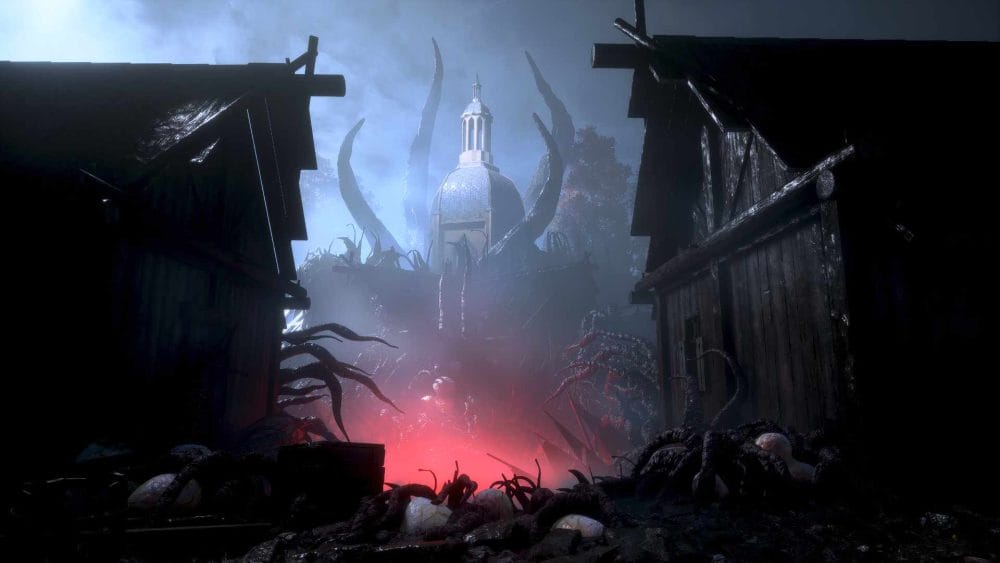
Exploration in Veilguard shares similarities with Inquisition. Fast travel is convenient and can typically be accessed at any time from the map menu. However, not all areas are available right away. As you progress through the main quest acts, new sections of previously visited locations will open up, offering additional quests, puzzles, and opportunities for discovery.
A word of caution: one aspect of the game I wasn’t prepared for was how advancing the main story too early can quickly lock you out of side content. To fully experience everything the game has to offer, it’s highly recommended to prioritize completing side quests and companion missions before progressing with the main storyline.
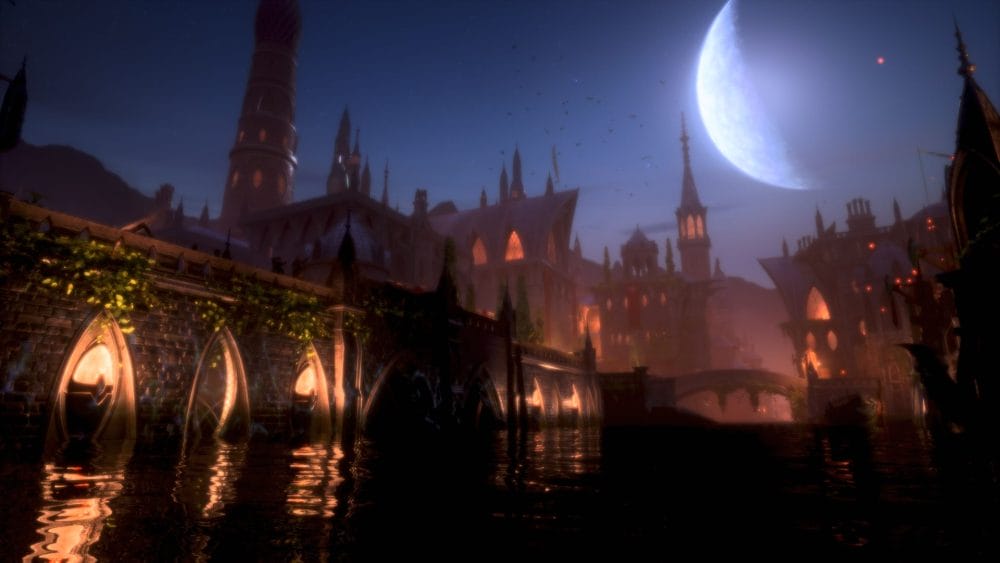
A History of Thedas
Long-time fans of the series will find much to love in Veilguard. The game dives deep into Dragon Age lore, exploring the origins of the Blight, the legends of the dwarven titans, and Chantry stories about Andraste. Central to the story is the conflict between Solas and Mythal. You learn about their attempt to free the elven people from the rule of the elven “gods” who crowned themselves leaders of the Evanuris.
Side quests in the Crossroads involving Solas are particularly significant and should not be overlooked. Actively seeking them out is highly recommended, as these quests reward you with a collectible that can be placed at the Lighthouse-your base of operations-and provide valuable context about elven history. They delve into how the elves came to be and offer insight into why Solas originally imprisoned Elgar’nan and Ghilan’nain.

The story in Veilguard is rich and packed with details, offering plenty to digest. I found myself completely engaged throughout the game. The buildup to the ending is lengthy but rewarding. Once you enter the final acts, it’s one crazy ride to the finish. The game does warn you when you’re approaching the point of no return, allowing you to prepare and clean up everything you hope to before the final push.
A Fitting Conclusion
With multiple endings-some good, some bittersweet, and some bad-the conclusion feels impactful and worthy. It successfully wraps up the narrative arc that began all the way back in Origins, delivering a satisfying and emotional finale. I’ll admit, I felt sad yet satisfied when the game ended. It’s a definitive conclusion-there’s no returning to the game world, no final conversations with your companions after the credits roll.
This is a story that stands firmly on its own merits. BioWare is correct in stating that DLC does not need to be released to expand upon the narrative. It’s all here, delivered in one complete and cohesive package.
Companions
The heart and soul of Dragon Age: The Veilguard is really the companions. Over the course of your journey, you’ll end up recruiting seven different “specialists” to join your party. By the end of the game there wasn’t one companion that I wasn’t invested in. Each character comes with their own little quirks and ticks. Interactions and moments with your party are meaningful and the game is designed around bringing these characters to life.
While I can’t pinpoint one specific favorite character they all seemed to have stand out moments for me. I’d like to discuss two characters that have received a lot of attention.
Controversial Characters
One such character is Taash, who has been highlighted in many discussions for their non-binary storyline. While I felt that one scene in particular surrounding Taash came off as a bit childish and preachy, especially for a dark fantasy RPG, I still found myself deeply invested in their personal journey and loved their character.
Taash is navigating a full-blown identity crisis, torn between growing up in Rivain with a mother who clings to their Qunari heritage. They come across as young, brash, and just trying to find their place in a complicated world. Despite their internal struggles, I knew Taash always had my back and would beat the crap out of anyone who stood in our way.
The other character is Bellara, who has been described as “Disney”. I believe that anyone that judges Bellara off her first scene at the lighthouse hasn’t finished playing the game. Bellara clearly has ADHD, she likes to overexplain and she is wicked smart. While she has one goofy scene tinkering away at the lighthouse her character and storyline cuts pretty deep. Early on she opens up to you about her brother who vanished in an accident and is presumed dead. There’s a lot of heartache surrounding her character and depending on decisions made things get really dark.

Everyone Loves Rook
Not everything in Veilguard is perfect. One noticeable absence is the rivalry system from previous Dragon Age and Mass Effect games. There’s really no in-fighting or attitude amongst your companions. They can be too amenable with you and with each other. I missed the dynamics where party members could loathe one another or even challenge your decisions. In Dragon Age II, for example, being able romance your rival created a fire and passion between the characters. Similarly, in Dragon Age: Inquisition, failing to support your companions could lead to them outright abandoning your cause, a stark reminder of the stakes and their own agency.
Romance
I’d be remiss if I didn’t touch on the romance aspect of this game. This is one area where I felt pretty let down. Whether you enjoy romance arcs or not, they’ve always been a hallmark of BioWare games, going way back to Baldur’s Gate 2, Jade Empire, and Star Wars: Knights of the Old Republic.
In an IGN First coverage interview, game director Corrine Busche mentioned, “We really did want to keep them relatable, more grounded. Some of them are quite sensual. Some of them are more physical, some are more romantic, some are more spicy.” Unfortunately, after playing the game, this feels like blatant false advertising.
I chose to romance Lucanis, and for a significant portion of the game, I wasn’t even sure if we were officially “together.” He seemed to flirt more with Neve than with my Rook. It wasn’t until near the very end of the game that he showed any physical affection. Honestly, it left me feeling a bit hollow. Lucanis is a fantastic character, and I’ve since learned that some actual “spicy” cutscenes with him were apparently scrapped.
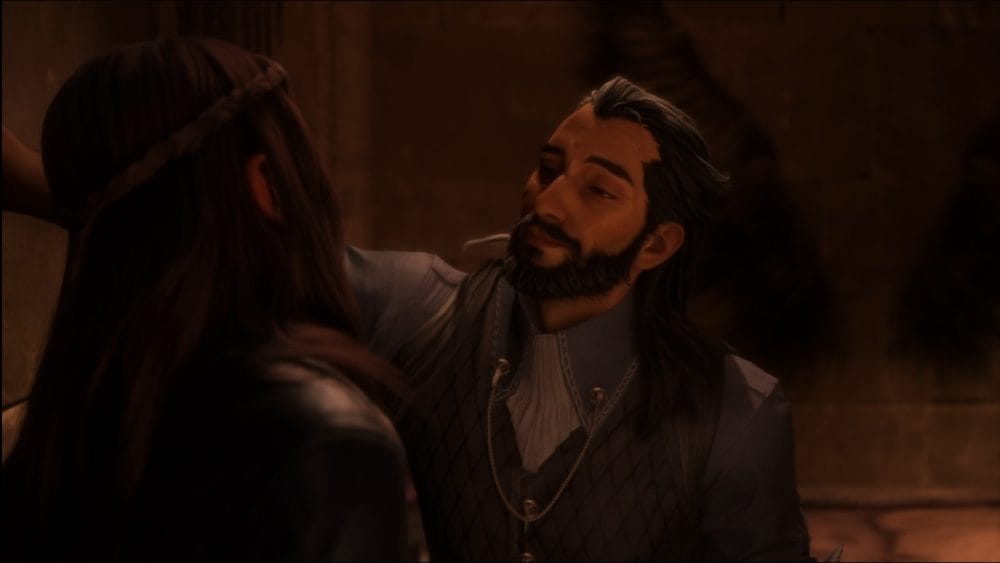
For comparison, Dragon Age: Inquisition offered a fantastic romance arc, probably one of the best in the series. There were frequent interactions with your love interest, and you could even kiss them in Skyhold whenever you wanted. I’m not sure what BioWare was aiming for here, but it feels like a missed opportunity.
The community outcry regarding the romance content is well-deserved, and I genuinely hope BioWare updates the game-Baldur’s Gate 3-style-to include what seems like missing or unfinished content.
Combat
Combat in the Veilguard is highly action-oriented, building on the changes introduced in Dragon Age II and Inquisition. Most of the fighting happens in real-time, with your party members acting independently. Using the tactical menu you can tell your party members which target to attack as well as direct them to use special skills when they are up.
I found the combat in the Veilguard to be incredibly satisfying. It was fast-paced, required quick thinking, and stayed consistently exciting. The variety of enemies encouraged strategic party selection, as leveraging each member’s innate abilities against their sworn foes added depth to the battles. By the end of the game, I still felt engaged and far from fatigued.
It’s a Group Effort
Certain classes synergize especially well, allowing for powerful combos and detonations. This makes it worthwhile to assemble a party of companions that work well with you and each other. Strategic party composition can significantly enhance your effectiveness in combat. It’s always something to think about before heading on a story mission, especially since you can only ever take two companions along with you. This is a big change compared to previous entries in the series, however combat seems very similar in style to Mass Effect.

Combat Mechanics
As a rogue, my abilities were tied to a momentum bar. Momentum builds as you strike enemies, allowing access to special abilities, but getting hit causes you to lose momentum.This system makes mastering dodging and parrying essential. Dodging is particularly useful for avoiding AoE and unblockable attacks.
Parrying, on the other hand, requires precise timing. When Rook gets a yellow bubble over their head, it signals an opportunity to parry. Successfully parrying not only blocks the enemy’s attack but also delivers a staggering counterblow. However, if a red bubble appears, it indicates an attack that can’t be parried, so dodging is the safer option.
Rook has an ultimate ability that charges as you fight. Like health pots, some battles feature vases you can break to gain additional charge. New traits, abilities and ultimate skills can be unlocked in Rook’s progression tree as you level up. The max level caps out at 50 for Rook and you can refund skill points at any point to tryout different combinations. No cost involved which is a nice perk. It’s a fantastic level up system with lots of customization options.
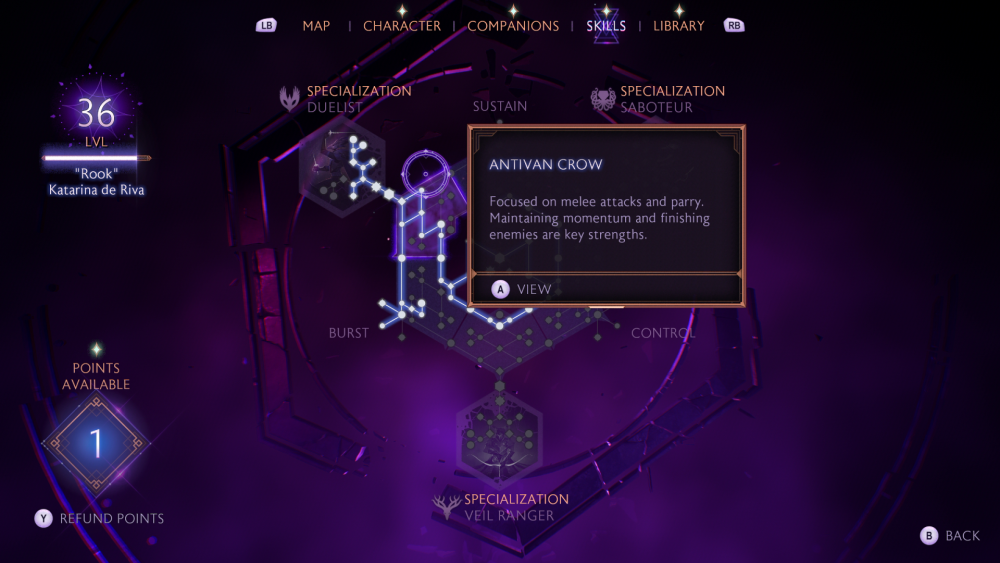
Staying Alive
When it comes to keeping yourself healthy in battle one thing you don’t have to worry about is your companions. They are immune to damage and can’t fall in battle – they don’t even have health bars. Everything is tied to Rook staying alive. Health pots are scattered throughout battlefields to aid recovery, and companions have equippable skills designed to support Rook’s survival. If you do get downed, you can use a revive, and certain companion skills can even grant you additional revives, making survival a manageable challenge.
Performance Issues
I played the game primarily in fidelity mode, and overall, it ran remarkably smoothly on the Xbox Series X. The only performance issues I encountered were during combat in the Hossberg Wetlands. For some reason, battles in that area, especially those involving numerous blight effects and darkspawn enemies, caused noticeable stuttering. While it wasn’t game-breaking, it stood out in an otherwise seamless experience.
Weapon and Armor Upgrades
Weapon and armor upgrades took a noticeable downgrade from Inquisition. Gone are the days of gathering materials to craft specific armor pieces tailored to your needs, which feels like a step back. In Veilguard, armor upgrades rely on picking up multiple copies of the same piece, which can then be leveled further by upgrading the Caretaker at the Lighthouse. This also unlocks the ability to place enchantments on your gear-no Sandal or Dagna here, as the Caretaker serves as a one-stop shop.
While functional, I missed the deeper customization options of previous games. The system often left me with a pile of gear I didn’t care about, hoping for something with the stats I needed rather than creating it myself. It made equipment feel less personal and more disposable.
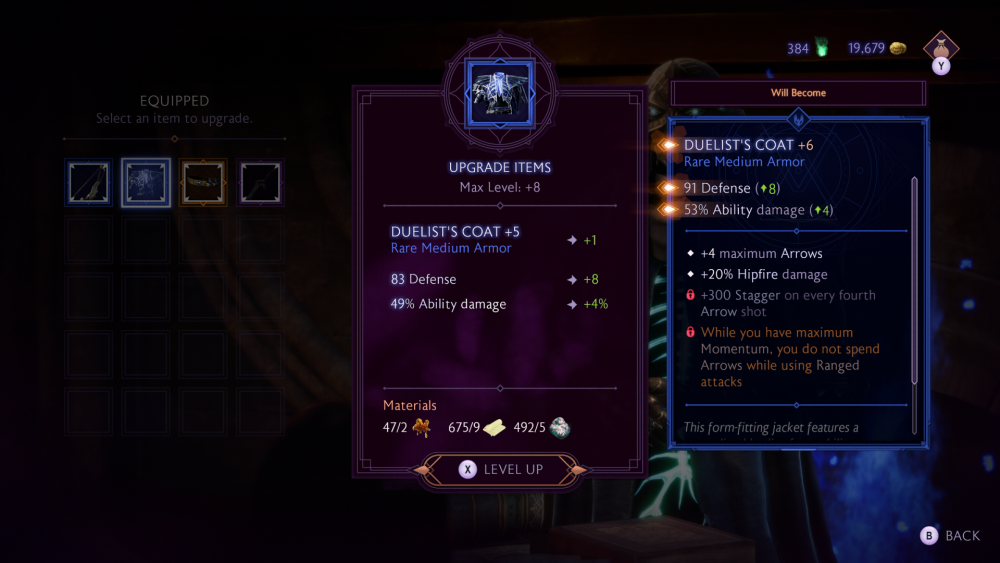
Final Thoughts
BioWare’s return to Thedas feels both nostalgic and fresh. The game builds on the foundation laid by its predecessors while addressing some of the modern expectations for RPGs. It balances its deep lore and intricate storytelling with gameplay improvements that feel like a natural evolution of the series.
The character customization system is a standout feature of the game, offering impressive depth and detail. While there are a few missteps, such as the easily overlooked Inquisitor customization, the overall experience is polished and engaging. Whether you’re here for the story, combat, or both, the game provides plenty of options to make the experience your own.
The story of Veilguard is sure to keep any Dragon Age fan pondering over what has been revealed. It’s a perfect continuation of the narrative that BioWare left us with in the Tresspasser DLC a decade ago, picking up where the story left off and sending us off on a freight train to the ending. The eclectic group of companions you meet along the way is unforgettable. It’ nearly impossible not to grow attached to at least a few of them. However, the game falters with its romance options, which feel overly simplistic and lacking in depth, especially for a Mature-rated title.
Combat in Veilguard is all about the action, with every battle leaving me wanting more. The adrenaline inducing encounters and extensive skill customization were an all-time high for the series. However, this excitement was somewhat dampened by a lackluster gear upgrade system, which felt underwhelming for an RPG of this scale.
Dragon Age: The Veilguard will undoubtably be my 2024 Game of the Year. I was fully engaged for my 100+ hour run, leaving me both and fulfilled and bittersweet when it came to an end. While additional content from BioWare would be a welcome addition, the game stands strong as a complete experience. I’m already looking forward to diving back in for another run.

Dragon Age: The Veilguard was reviewed on an Xbox Series X. Available now on PC, Steam, Xbox and PlayStation.



